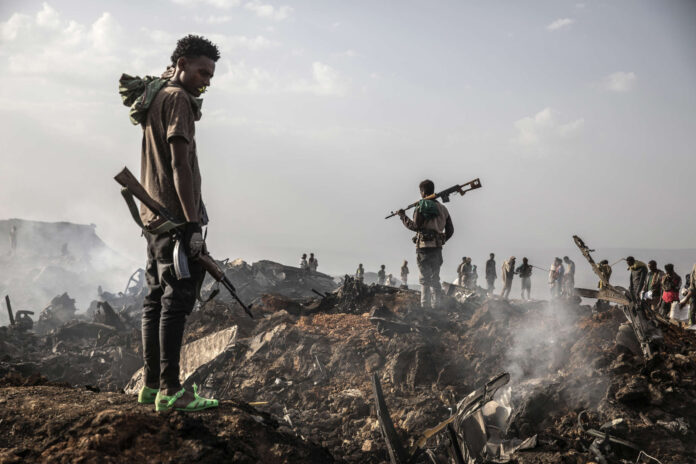Started two years ago, the Tigray war, which opposes the Ethiopian federal government to the Tigray People’s Liberation Front (FLPT) and the Oromo People’s Liberation Front (FLO) seems to be heading towards an end. final?
This conflict officially began on the night of November 3 to 4, 2020 when the Ethiopian government decided to launch an offensive following an attack orchestrated by the Tigray People’s Liberation Front (FLPT) against a base of the Ethiopian federal army located in the state of Tigray.
The reasons behind this conflict date back to the appointment of current Prime Minister Abiy Ahmed as head of the federal government and the reforms he has undertaken since.
Indeed, since the entry into force of the 1994 constitution, Ethiopia is a federal state divided into regions, also called States, which are established on ethnic bases. For decades, Ethiopia has been ruled by the same coalition, the Ethiopian People’s Revolutionary Democratic Front (EPRDF) within which the Tigrayan minority holds a very significant share of power considering its population, which represents only 6 % of that of the country. This hegemony is illustrated by the mandates of the Tigrayan Prime Minister, Meles Zenawi from 1995 to his death in 2012.
Due to socio-political unrest that led the country to the postponement of municipal elections, and the resignation of Prime Minister Haile Mariam Dessalegn, the EPRDF then appointed a new man, Abiy Ahmed as Prime Minister of Ethiopia on 02 April 2018. He undertook a vast program of reforms, in particular the release of political dissidents, an opening of the democratic space as well as the return to peace with Eritrea. This achievement, acclaimed by the entire international community, earned him the Nobel Peace Prize on October 11, 2019.
The new Prime Minister, wishing to give a new face to the political institution of the federal government, decided to reform the EPRDF coalition, within which the State of Tigray held a significant share of power, thanks to its leaders who occupy key positions.
The return to peace with neighboring Eritrean has sparked even more tension with Tigray, this region being particularly exposed to clashes and territorial claims between the two countries during the conflict between them in 2000. The FLPT accuses Ethiopian Prime Minister Abiy Ahmed, an Oromo (the largest ethnic group in Ethiopia) for having gradually marginalized the Tigrayan minority (6% of the population) within the ruling coalition, which the party left since 2018, following its reform.
Dissatisfied with the new policy put in place by the new strongman of the federal government, the Tigray People’s Liberation Forces (FLPT) attacked on November 04, 2020, in addition to Dansha, the largest military base of the Ethiopian federal government located in Mekele, the capital of Tigray. The Tigray region accounts for more than half of the country’s entire armed forces and mechanized division personnel in the Northern Command because of the Eritrean-Ethiopian war.
According to a report by the International Crisis Group (ICG) think tank published at the end of October 2020, around 20% of the total personnel of the Ethiopian federal army are from Tigray and have largely been deserted. Having returned under the command of the Tigray rulers, the Tigrayan authorities can therefore count on “a large paramilitary force and a well-trained militia”, whose combined strength is estimated at 250,000 men and “appears to enjoy significant support six million Tigrayans” because the local people provide them with food and logistical support.
In response to this attack orchestrated by the FLPT on November 04, 2020, the federal government declared on November 05 2020, a state of emergency for 6 months, and launched a large-scale offensive with heavy artillery against the FLPT, in the hope to regain control over the state of Tigray. A range of actors have become involved in the conflict, including Amhara, a state bordering Tigray in the center of the country. Its fighters support the government forces there. They have taken control of fertile lands in the south and west of Tigray, territories claimed by the Amharas since a regional division carried out in 1991 by the TPLF for the benefit of Tigray. The United States called the campaign “ethnic cleansing”, a charge denied by the authorities.
On November 7, 2020, the Federation Council, Ethiopia’s upper house, met in extraordinary session and approved a resolution to establish a transitional government in Tigray; this decision meaning that the Ethiopian Parliament suspends the provincial authorities of Tigray.
Moreover, Eritrea, which has maintained healthy diplomatic relations since the return to peace, does not hesitate to provide military support to the federal army.
On November 14, three M20 tactical ballistic missiles were fired from the Tigray region towards Asmara, the capital of Eritrea. These shots were claimed the next day by the FLPT who accused the Ethiopian army of using Asmara airport to bombard the region and therefore considered it “a legitimate target”. Debretsion Gebremichael, accused Eritrea of committing its forces to the ongoing conflict, charges denied by the country.
The war between the two camps reached its climax when the federal army, after taking over several towns in the Tigray region, managed to reach its capital on November 29, 2020. The whole region began to face shortages. On December 14, 2020, electricity partially returns, as well as the telephone in the city of Mekele, but with food, water, and gasoline shortages still; in parallel, the Tigray airspace is reopened on the same date. The government is asking public employees to return to their posts and go about their business.
Although they had not controlled any major cities for a long time, Tigray leaders who had deserted the capital, Mekele, repeatedly claimed to be regrouping in remote rural areas. Together, the Tigray People’s Liberation Front (FLPT) in coalition with the Oromo Liberation Army, decide to launch a joint offensive on April 18, 2021, three days before the national elections.
Thus, on June 28, 2021, seven months to the day after leaving the capital Mekele in the face of the assaults of the Ethiopian federal army, the regional capital was retaken without a fight by the Tigrayan Defense Forces and in the evening, the Ethiopian government made the following announcement: “In order that farmers can cultivate peacefully, that humanitarian aid can be distributed without any military activity, that the residual forces of the TPLF can return to the path of peace, a unilateral and unconditional ceasefire has been decreed from today until the end of the cropping season”.
In July, the federal government and the Tigrayan forces began negotiations for a ceasefire, after the Tigrayan forces recaptured a large part of the towns bordering the region, following the withdrawals of the federal army due to the humanitarian ceasefire.
On Thursday, July 16, three Ethiopian regions, although not bordering Tigray, Oromia – the largest and most populated in the center of the country -, Sidama and the Southern Nations, Nationalities and Peoples Region (SNNPR) – both neighboring Oromia – confirmed the deployment of “special forces” to contain military operations on the Tigray front. Armed support that paves the way for a widening of the conflict.
On August 10, the unilateral humanitarian ceasefire announced by Addis Ababa is lifted, and the federal government resumes the war. This moment is marked by a call for general mobilization made by Prime Minister Abiy Ahmed. He explains that “this is the time for all able-bodied Ethiopians of legal age to show their patriotism.”
The fighting lasts until December 20, 2021 and leads the Tigrayan defense forces after months of struggle to withdraw from the Amhara and Afar regions to open the door to humanitarian aid. Tigray again in the grip of a violent shortage, the Tigrayan authorities now seem open to a bilateral ceasefire to meet the needs of the trapped population. The withdrawal of these two regions was demanded by the government as a prerequisite for any negotiations. The spokesperson for the FLPT after this withdrawal announces in a press release: “our bold act of withdrawal will be a decisive opening for peace”. The federal government took advantage of this to reconquer certain important towns in the Tigray region, notably Waja, Alamata, Sekota, as well as the entire Amhara region except for the town of Arddi Akey.
Prime Minister Abiy Ahmed, in response to the initiative led by the Tigrayan authorities, launched on January 07, 2022 a call for “national reconciliation”; the same day he announced the amnesty of several opponents of the regime, including members of the FLPT. The government clarifies that these releases are intended “to pave the way for a lasting solution to the problems of Ethiopia, in a peaceful and non-violent manner” through “national dialogue”.
Gradually, the conflict experienced a decrease in intensity between the two camps, notwithstanding a few drones strikes by the federal army in the days that followed at the Dedebit displaced persons camp and in the town of Mai Tsebri on 7 and 10 January. On March 24, 2022, the Ethiopian government declared an indefinite humanitarian truce to allow the delivery of humanitarian aid to Tigray.
The damage orchestrated by this war since its beginning in 2020 is extremely significant.
Pre-crisis malnutrition in Tigray was already on the rise due to COVID-19 and the locust infestation, with a 34% increase in admissions of severely malnourished children between January and August 2020, compared to the same period in 2019. In mid-December 2020, 950,000 displaced persons linked to this conflict were recorded, including 50,000 refugees in Sudan.
As of 15 January 2021, with supply routes cut and the harvest season affected by the conflict, reports indicate that food is not available or is extremely limited in markets in camps in Sudan. In addition, several refugee camps in the province of Tigray have been the object of material destruction and violence.
On February 26, 2021, Amnesty International denounces crimes against humanity in Tigray. The human rights association has collected dozens of testimonies which detail summary executions “of hundreds of civilians”, perpetrated at the end of November 2020 by the Eritrean army. In its report, Amnesty calls for an UN-led investigation into the violence in Axum, as part of a wider international investigation into the conflict which began on November 4.
The report comes amid growing international pressure for Ethiopian Prime Minister Abiy Ahmed, who came to power in 2018, to restore peace. Ethiopia receives hundreds of millions of dollars in annual aid from the United States and the European Union. Ethiopian and Eritrean officials have denied that Eritrean forces were involved in the Tigray conflict, despite witness accounts. After the report was released, Eritrea’s Information Minister Yemane Gebremeskel challenged Amnesty’s research methods, accusing it of bias.
If initiatives are taken by the two major players in this war to find a lasting and diplomatic solution to the problem, the chasm that has been created between the states of the Ethiopian federal government seems enormous, and if real solutions are not made quickly, this risks weakening the country for future generations.





